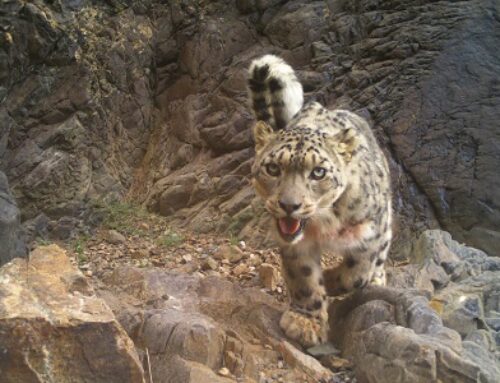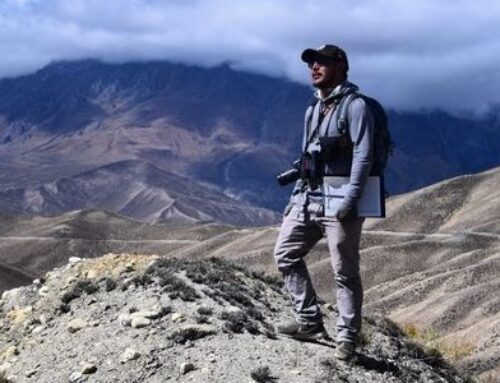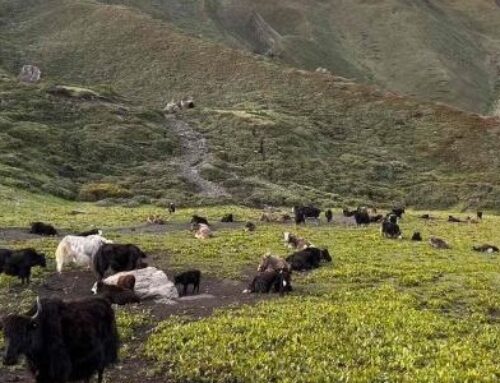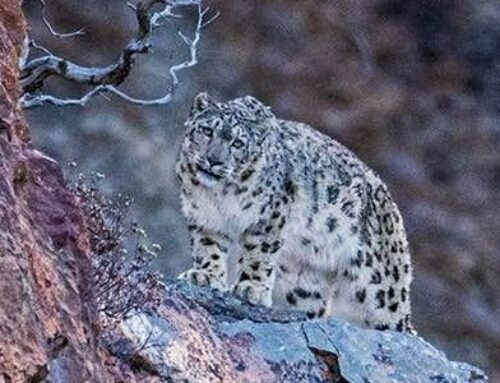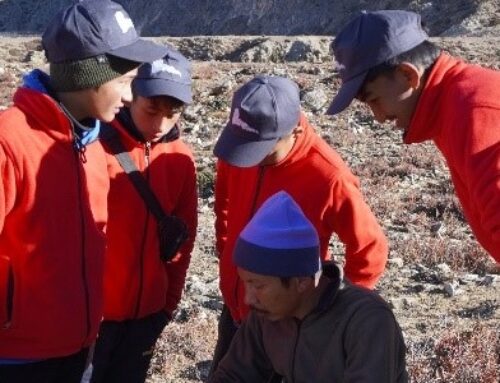by Vikram Singh
What is it like to encounter not one, but three wild snow leopards when you weren’t expecting to? Read about Vikram Singh’s experience as he just happened to glance down the moutainside while waiting for the road he was traveling on to be cleared of snow. Referred to as the Chief Explorer at his company Wild World India, he leads wildlife tours. This happenstance encounter was one of his most exciting adventures.
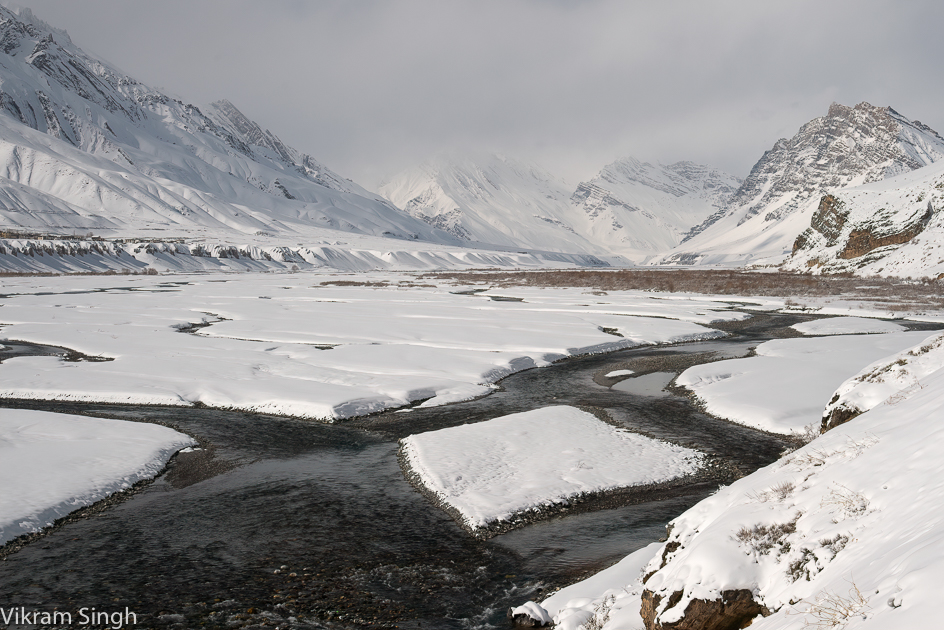
Sitting precariously on a mountain slope at 4200 meters above sea level, with a wind chill that makes the temperature feel like minus 30 C was brutal. On my left was a sheer drop to the meandering Spiti river at the valley bottom, steam rising off its frozen surface, not the ideal conditions for your first day out in the high Himalayas when you are better off acclimatizing to the altitude. Agonizing as it was, I didn’t complain as I was sharing this space alone with a family of three snow leopards.
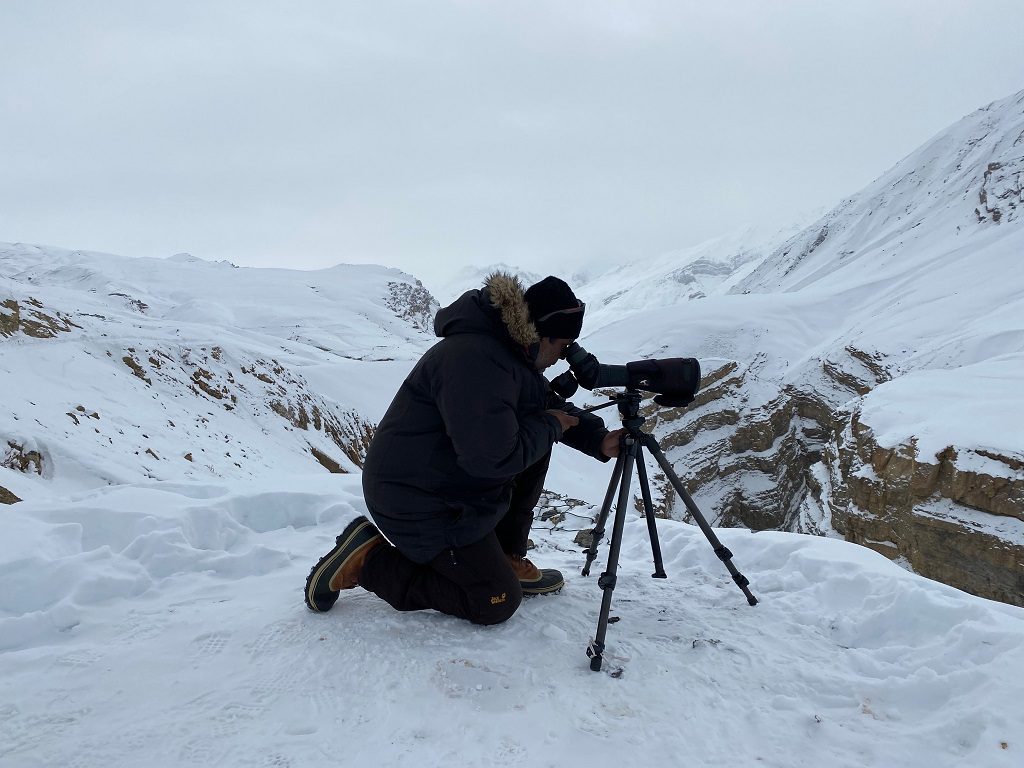
I first sighted the cats from the road above, all three of them standing side by side at an outcrop on a ledge of the mountain slope, looking down at the valley stretching below. They decided to settle down there. It was a perfect bedding site, well concealed from both prey and predator, offering spectacular vistas of the open valley stretching below.
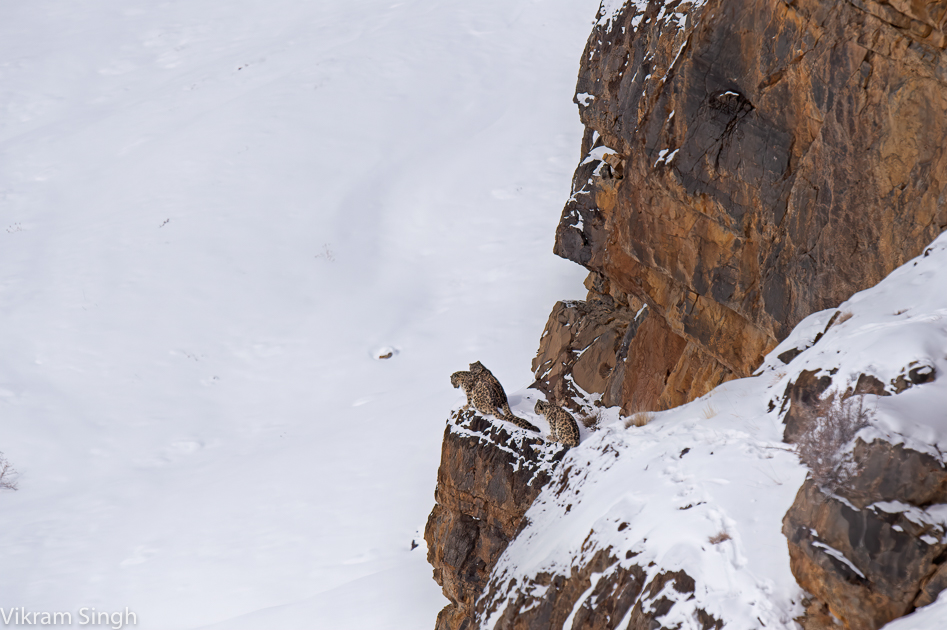
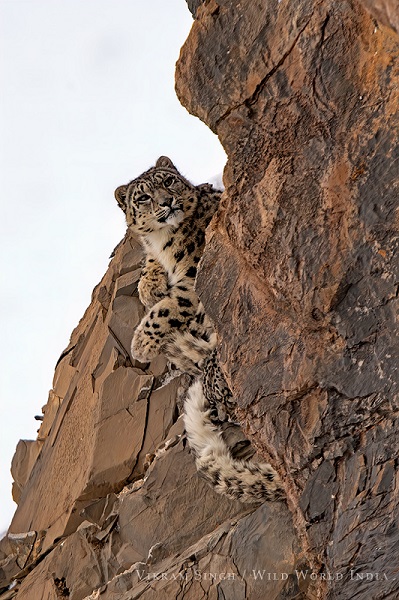 The mother lay down curled up right at the edge, wrapping herself with her long, furry tail while the cubs settled together in a broken vertical crag behind, awkwardly huddled one on top of the other. These were not the first snow leopards I had seen, but it was by far my most spectacular sighting.
The mother lay down curled up right at the edge, wrapping herself with her long, furry tail while the cubs settled together in a broken vertical crag behind, awkwardly huddled one on top of the other. These were not the first snow leopards I had seen, but it was by far my most spectacular sighting.
Having arrived at the town of Kaza in the Spiti Valley only the night before after a grueling two-day drive, I couldn’t have hoped for a better start. As luck would have it, the road ahead to Kibber Sanctuary (my final destination) was blocked due to heavy snow, and I was biding my time when I stumbled upon these cats. Totally unprepared for what was in store, I had not even had the chance to slip into my proper winter gear, including basics like gloves, ski-pants, thermal inners, snow boots and a tripod, which still remained neatly packed away in a bag at the trunk of my car.
Once the cats settled and I had gotten a few shots, I decided to approach them closely. Taking the trail in knee-deep snow, big lens in one hand, I trudged down the mountain, maintaining a respectable distance from the edge. I was not quite sure where I would end up, but it was worth a try. I came to the end of the trail and took a look down somewhat nervously only to find three intense pairs of eyes staring right through me at less than 100 meters. It seemed they were expecting me, and my walk down was not as discreet as I would have liked it to be.
Placing my camera bag in front of me like a shield, I sat down sheepishly feeling a little less exposed. The mother gave me a long, piercing stare, turned back to look at her cubs, and then looked at me again before going back to sleep peacefully. Taking it as a sign that I could hang around as long as I behaved, this was just the approval I was hoping for. With the pressure now off, I knew that I would be here for the long haul.
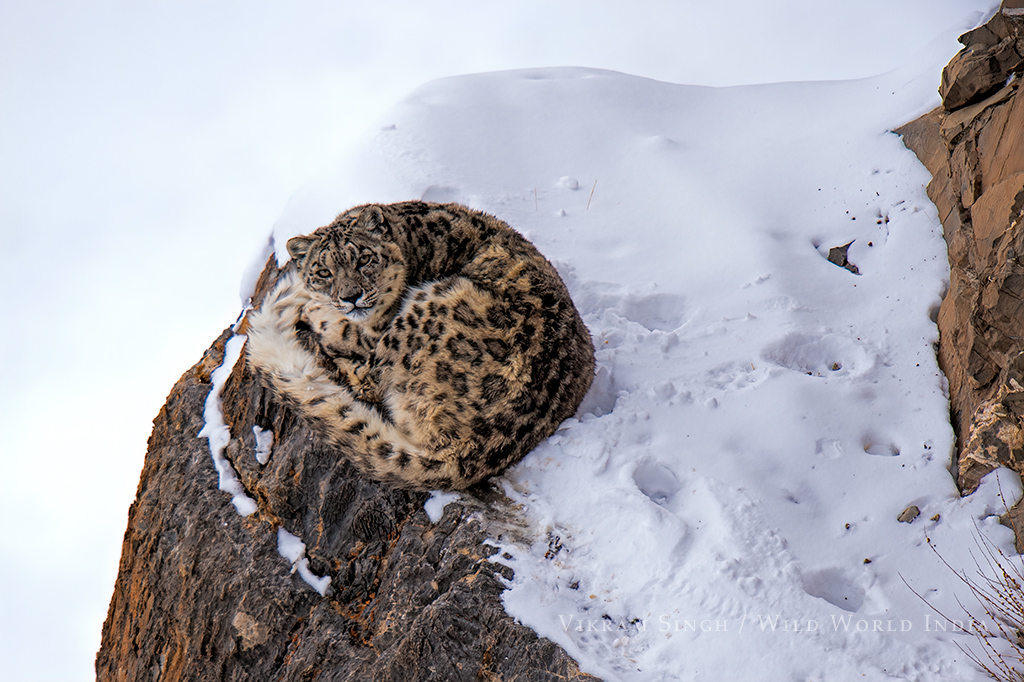
The mother was in her prime, around five years of age, with no visible injuries or scars. This was probably her first litter. The cubs looked just short of two years. Like most big cats, they would soon move on to lead a solitary life. The cats were well-fed, and the mother slept the entire time I was there, conserving energy for the next kill. Her hunting prowess would be tested to feed the family. Adult females are associated with cubs for most of their lives, which is not an easy feat, raising a family in this harsh environment.
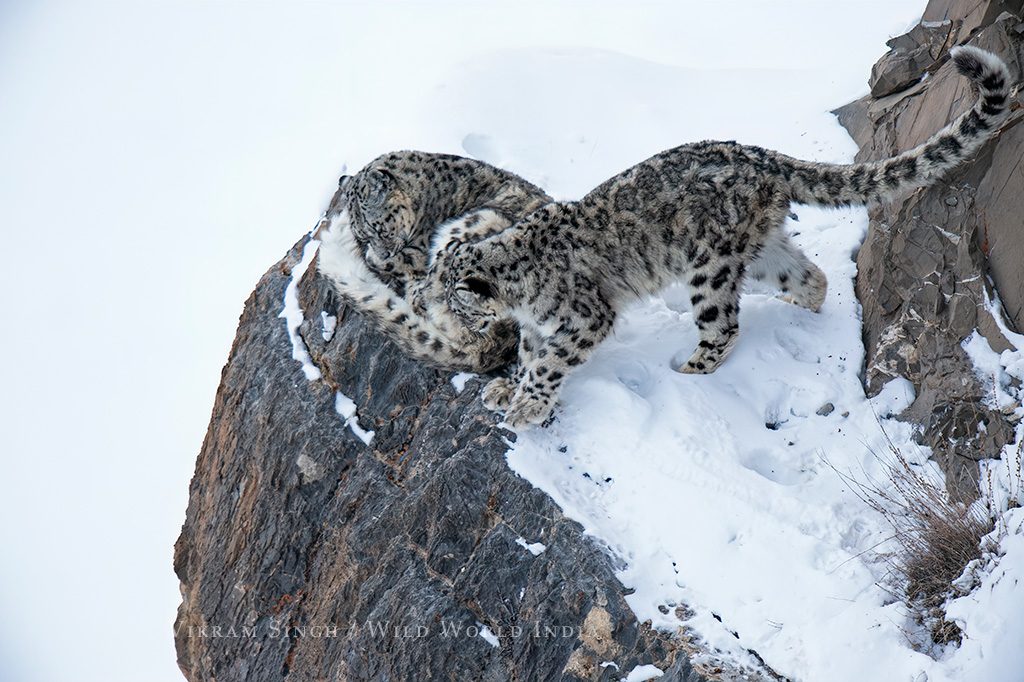
The cubs, though sizable yet still inexperienced, showed a lot more curiosity and displayed their agility in this rugged terrain. The bolder of the two showed a keen interest in me. After sizing me up from his perch, he decided to approach me closely. Crouching low with eyes locked on me, he took small strides towards me, only to stop 50 meters short of me and change direction to disappear in the crag. Even at such close quarters, he showed an uncanny ability to completely merge with his surroundings, and it took an effort to locate him.
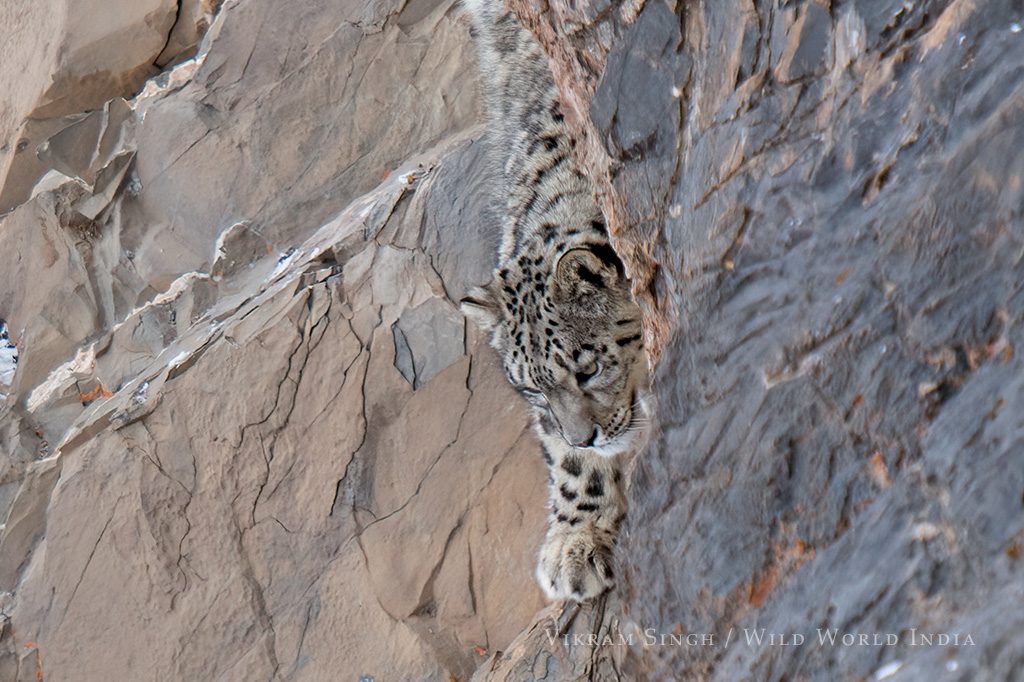
This friendly frolic went on for some time. However, at no point did I feel scared, and nothing in the body language of the young cat showed that he felt threatened. Though on one occasion, if he had approached me any closer, I would have had to move to distract him or give a shout-out to his mom to intervene. After a while his interest in me waned and shifted to the hill pigeons perched nearby. I can tell you that it’s a lot of fun being stalked!
Snow leopards may be the most peaceful of all apex predators and there are no records of them attacking people, which was reassuring to know. This could be part of the reason for their success in some places where they live in close proximity to humans.
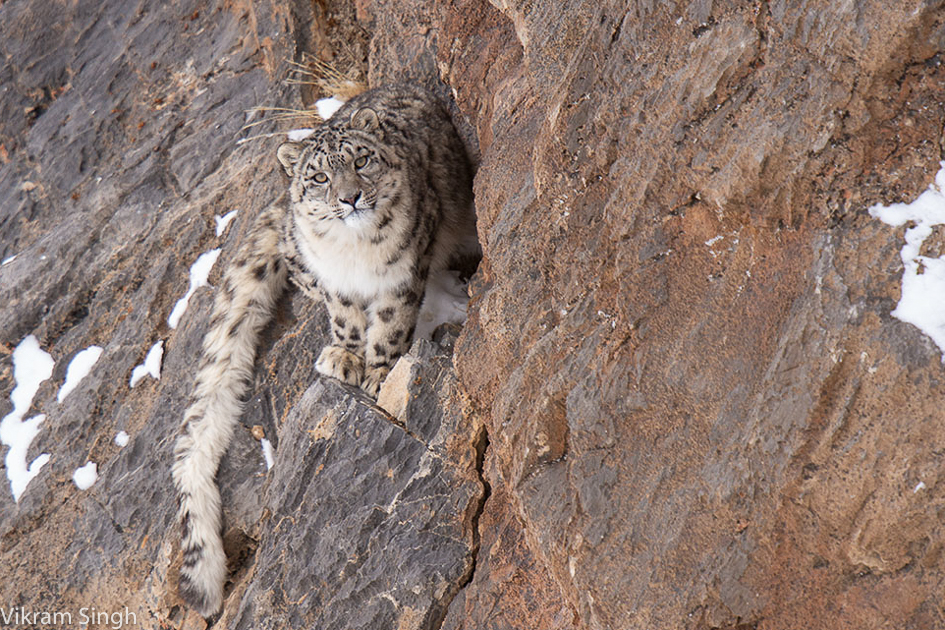
Photographing this behavior so closely, I couldn’t help but feel a little guilty. Until a few decades ago, wildlife researchers and biologists, studying the behavior of snow leopards, would spend years in the field before actually seeing one in the wild. It was only in 1971 that American biologist George Schaller photographed the first Snow Leopard in its natural habitat. And it would take another decade before the next picture was to come from the wild.
The light was now fading fast, and temperatures had plummeted while gusts of wind were throwing up snow hampering my visibility. The mother was still asleep, but the cubs were getting increasingly restless. I had spent close to six hours at this uncomfortable spot. The cold had seeped through every pore of my body, my fingers too numb to even press the camera shutter. After the first couple of hours, I had to constantly rub my hands to keep the sensation going which caused me to miss a lot of shots. My feet felt worse, and my muscles were cramped confined to the ledge in the bitter cold, but I was not going be the first to leave the scene.
The bolder cub was the first to move, yawning infectiously all the while. He took the slope vertically below me, stopped to defecate, and gave me a parting look before vanishing out of my sight abruptly. We had forged a bond, and I felt sad to see him go. The other one soon followed, walked up to his mother, nuzzled her, and went in the exact direction as the first one.
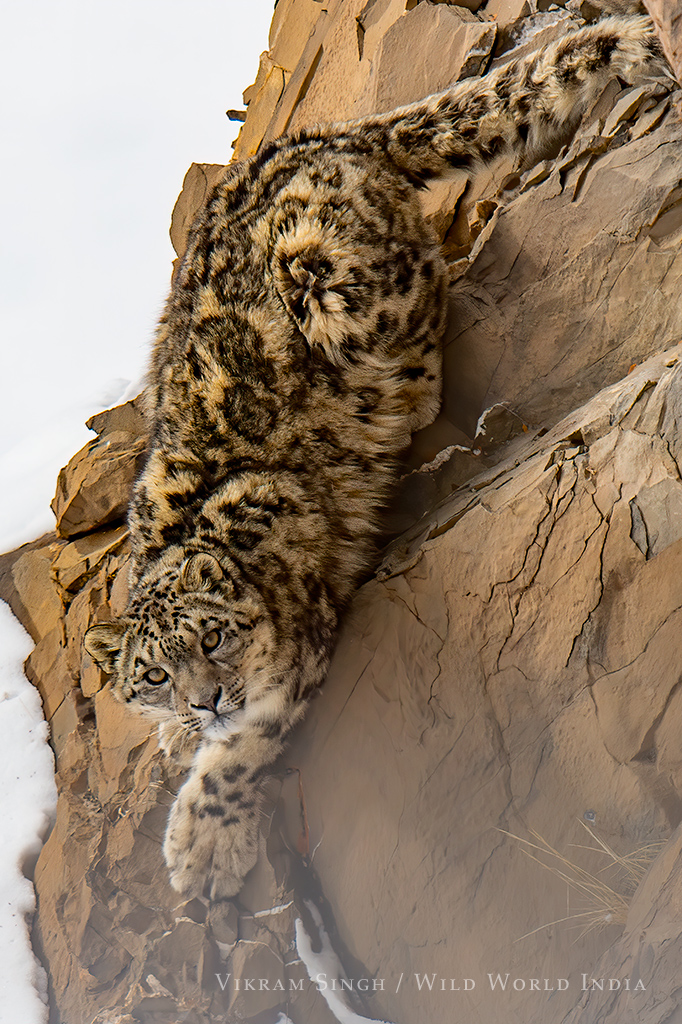
I could now hear sounds from above. I guessed the road would have opened and my local friends were looking for me. The noise caught the mother’s attention and got her to look up in the direction of the road, ears alert and eyes wide open. She stood up gracefully, surveyed her surroundings, and made eye contact with me one last time before slipping away into the ether.
Some days later during the same trip, in a dramatic hunting display, I observed an old male attempt to throw an Ibex down a cliff but instead fall about 50 feet into a gorge, crashing against rock and ice as it went down. Surprisingly, the cat landed on his feet and came out unscathed. I found him again the next day still focused on its prey and desperate to make a kill. A month later after my return, I found out that this old male fell to his death chasing an Ibex in a similar manner.
Snow leopards are native to the mountain ranges of Central and South Asia, occurring in 12 countries, with an estimated total population anywhere between 4000 – 7000 individuals as per International Union for the Conservation of Nature (IUCN). In India, they are reported in five states that lie in the Himalayas. But it’s the contiguous mountains of Ladakh and Spiti in the trans-Himalayan range that offer the most realistic chance of finding these cats in their natural habitat which supports a healthy prey base.
Since my first snow leopard expedition to Hemis National Park in Ladakh in 2009, I have visited these parts of the Himalayas every winter. With sightings of snow leopards getting more predictable in recent years, these remote areas have witnessed a steep growth in winter tourism, bringing with it some much-needed revenue to the local communities in the remote mountains where people have traditionally relied upon livestock and agriculture as the only source of income.
The state forest department and NGO’s like the Snow Leoaprd Conservancy in addition to implementing a number of community-based conservation initiatives such as predator-proofed corral construction for livestock and education, have also introducted alternative livelihoods like handicrafts, livestock insurance, and home-stays for visitors, and snow leopard trekking.
Even though these places are largely Buddhist, which forbids killing of animals and promotes living in harmony with all wild creatures as its core principle, hunting for food and retaliatory killings by villagers for livestock lost to snow leopards in the villages was not uncommon. Ecotourism has emerged as a viable alternative livelihood and has helped reduce the human-animal conflict. Snow leopards in the trans-Himalayas of India will still require continuous close monitoring, however, as uncontrolled tourism can pose a serious threat to this fragile environment and the wildlife it supports.
Vikram has been a full time professional tour leader for over ten years. Having developed a late interest in photography, he now carries a camera along on his travels besides open eyes and binoculars. An engineer and a MBA by training, he gave up a short-lived, lustreless career in the corporate world to pursue his interest in the natural world and travel. Based in New Delhi, he is the owner of Wild World India and has traveled extensively through India and beyond to Africa, the Arctic, and the Brazilian Amazon. Some of his favourite haunts are the Himalayas and the Arctic.
Vikram was joined by the Conservancy’s Outreach Manager Shavaun Kidd and Vice President Ashleigh Lutz-Nelson on May 20, 2021 for a “Cat Chat” about wildlife photo trekking, ecotourism, and their impact on snow leopard conservation.
Conservancy Cat Chat featuring Vikram Singh from Wild World IndiaJoin us as we talk with Vikram about his experience traveling throughout the Himalaya and around the world and the impact of ecotourism on conservation.
Posted by Snow Leopard Conservancy on Thursday, May 20, 2021

